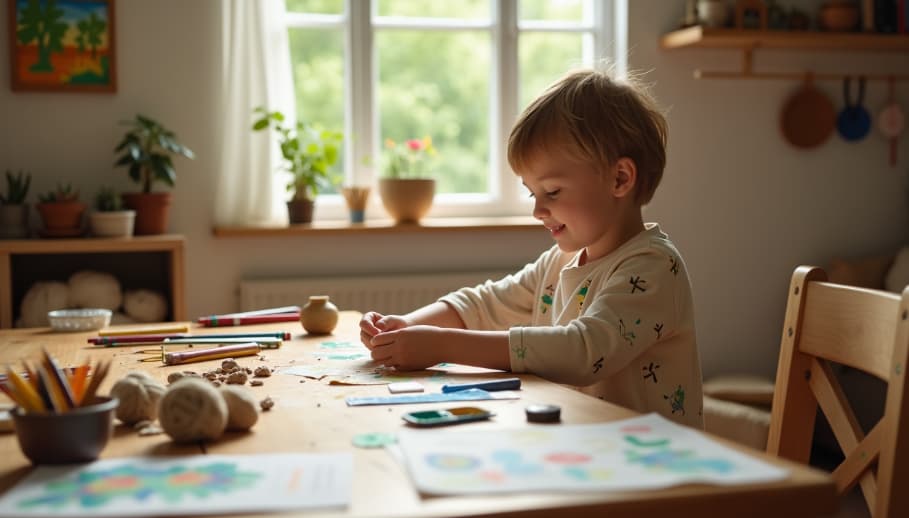Growing up, all my parents cared about were grades. They made me feel that if I got good grades, that was what made me lovable, and if I didn’t get perfect scores…
Well, lets just say that that was part of why I unschooled my kids, because I wanted my kids to have a love of learning and I felt that pressures that schools gave on good grades takes away that love of learning. I let them know that I didn’t care at all about grades, I cared about them enjoying to learn. (Ha, joke’s on me, my kids all care a lot about grades, even if I don’t.)
But the thing is, with the way the world is evolving today, creativity matters a lot more than grades these days. Read on to find out why, and how to nurture your kids’ creativity.

Children playing with minimal toys show something amazing – their creativity naturally blooms without limits. Our education system puts grades and test scores first, but we now know creative thinking could be the most valuable skill our children can develop.
Kids don’t need art projects or craft supplies to be creative. They need space to explore and experiment. Sometimes they need to feel bored. These quiet moments lead to their most innovative ideas and help build their confidence and resilience for the future.
This piece will show you why creativity matters more than grades. You’ll learn how to build an environment that supports creative thinking and practical ways to help your child develop this vital skill for future success.
The Changing Landscape of Success
The definition of success is shifting in ways that challenge traditional expectations. The skills that once defined achievement are no longer enough in a world that values adaptability, problem-solving, and creative thinking.
As industries evolve and technology reshapes job markets, new opportunities open for those who can think beyond conventional measures of success. Understanding this shift is essential for preparing the next generation to thrive in an unpredictable future.
Why yesterday’s metrics don’t predict tomorrow’s achievements
The educational world is moving faster beyond standardized tests and letter grades. Recent research shows a stark reality – just 38% of educators and 56% of hiring managers believe today’s graduates are ready for work, despite their academic credentials. Basic literacy and numeracy skills matter but they don’t tell the whole story about a child’s potential.
Something big has changed. Skills that once guaranteed career success don’t matter as much in today’s ever-changing economy. Creative thinking will become crucial for workplace success as AI revolutionizes industries – 85% of hiring managers agree. Many current child assessment tools look at narrow skills that don’t consistently link to long-term success.
Kids need room to develop flexible thinking and innovative problem-solving abilities that surpass traditional measurements. The home environment gives children this creative space that standardized education often misses.
How creative thinkers are altering the map
Creative thinkers lead the charge in today’s most dynamic industries. More than three-quarters of hiring managers now favor creative thinkers in their hiring decisions. Creativity stands among the top three most valued skills at 57%, right next to problem-solving at 58% and communication at 55%.
This transformation keeps gaining speed. About 70% of companies list creative thinking among skills they expect to become more important between 2023 and 2027. Jobs that need creativity will likely grow as a bigger part of the job market by 2030.
Parents should know something crucial: creativity stays uniquely human while technical skills can become outdated. Despite tech advances, 85% of hiring managers think AI will make creative thinking more necessary rather than replace it. One researcher puts it clearly: “If robots have taken over many jobs because those jobs involve routine, algorithmic physical or cognitive labor, then about the only thing left for humans will be the stuff that robots can’t do”.
Supporting kids’ creativity through daily activities and play does more than keep them busy. We help them build exactly the skills that will set them apart in tomorrow’s world.
Essential Creative Skills for an Uncertain Future
In a world that changes faster than ever, creativity isn’t just about making art—it’s about thinking in new ways, solving problems, and adapting to whatever comes next. The ability to stay flexible, approach challenges with originality, and express ideas across different platforms will be key to thriving in the future. By encouraging these skills at home, parents can give kids a strong foundation for success in any path they choose.
Adaptability and flexible thinking
Kids who think flexibly can change their view when situations shift. This vital skill helps them handle unexpected changes without stress or worry. Research shows children with mental flexibility have a growth mindset and welcome new experiences instead of resisting them. They excel at looking at problems from different angles and can adjust their approach when the original plan fails.
You can build this skill at home by changing your daily routines sometimes. Show flexibility by talking through changes in plans: “I wanted to take you to the park, but it’s raining. Let’s build an indoor obstacle course instead!”
Innovation and original problem-solving
Kids who solve problems creatively come up with unique solutions rather than following standard steps. They understand things better when they tackle challenges through critical thinking and ask questions to test their ideas.
You can develop this skill through:
- Building with open-ended materials
- Breaking big problems into smaller parts
- Asking questions that spark exploration
Resilience in the face of failure
Creativity and resilience go hand in hand. Studies show creativity training substantially increases children’s resilience. About 94% of trained children found solutions to common and personal problems, while less than half of untrained children could do the same. Creative kids see setbacks as chances to learn rather than failures.
Let your child work through challenges. Don’t jump in to fix things when their first try doesn’t work. Help them identify what they can control and think of other options.
Communication across platforms and mediums
Good communication remains one of the most valuable skills in any profession. Modern communication covers digital platforms, visual presentations, and team collaboration.
Encourage different ways of self-expression at home – from telling stories to creating art. This helps kids build confidence to express themselves and understand others’ views. These social skills and empathy will serve them well throughout their lives.
Creating a Creativity-Friendly Home Environment
A child’s surroundings play a big role in how their creativity develops. The right balance of inspiration, structure, and freedom helps kids explore ideas, try new things, and build confidence in their creative abilities. Small changes in how a home is set up and how time is managed can make a big difference in nurturing imaginative thinking.
Setting up spaces that inspire kids being creative
You don’t need fancy resources or a huge space to create a dedicated creative area. A simple corner of your dining room can transform into a creativity hub with good organization. Kids need to see their materials to use them, since “kids often forget about things they can’t see.” An art cart or pegboard keeps supplies handy and teaches responsibility.
These elements help boost participation:
- A flat work surface positioned near natural light
- Open storage that displays materials by category
- A display area at your child’s eye level for showcasing work
- Comfortable seating that encourages extended focus
Studies show that blues and greens boost creative thinking because they connect with nature. Your child’s desk should face into a room or toward a window instead of a wall to expand their thinking.
Balancing structure with freedom
Kids do better with both boundaries and independence. They need structure for emotional security and freedom to explore and express themselves. One expert points out, “We need to teach our students to integrate technology into their learning while also making sure they’re staying focused.”
This balance shows up when you set clear expectations without jumping in to fix every challenge. Your child learns self-regulation and creative expression through designated creative times and flexible boundaries.
Managing digital distractions
Our brain works with two attention systems: reactive attention responds automatically to stimulating input, while focused attention requires deliberate concentration. Digital media mostly triggers the reactive system and can weaken the deep focus needed for creativity.
Make specific times screen-free, especially during meals and family activities. Research shows children learn best through “live, immersive interactions with family members” rather than screens. Limited digital distractions create room for boredom that often leads to creative breakthroughs.
Everyday Opportunities to Nurture Creative Thinking
Creativity doesn’t have to be reserved for special projects—it can be woven into daily life in simple and meaningful ways. Whether it’s turning ordinary routines into fun challenges, encouraging artistic expression, or making the most of time spent outdoors, everyday moments provide endless opportunities to spark curiosity and imagination.
Turning household tasks into creative challenges
Kids usually groan at chores, but a creative spin makes these tasks fun and engaging. A simple bed-making task becomes “The Floor is Lava” challenge when kids complete it without touching the ground. Clean laundry turns into “Sock Go Fish” as family members pick from a shared pile until they match all pairs.
A timer can make cleaning feel like an exciting race creating gameplay from routine tasks. Music, podcasts, or audiobooks create “joy-time” that makes work feel less like work. Younger kids love it when toy pickup becomes a scavenger hunt. You can also add googly eyes to cleaning tools to give them personality.
Engaging in Hands-On Artistic Activities
Simple art supplies placed around your home let kids create whenever they feel inspired. Kids can make amazing effects with watercolors by painting over crayon or sticker designs. The resistant materials create beautiful negative spaces naturally.
Nature provides endless creative possibilities. Your kids can make memorable collages or “nature quilts” using leaves, twigs, and flowers they collect during walks. To name just one example, kids can create colorful “glass” sculptures from coffee filters using markers and spray starch.
For a more structured yet equally engaging experience, exclusive paint by numbers kits provide a fun way for kids to experiment with color, build confidence, and create artwork they’re proud to display.
Using nature as a creativity catalyst
Time outdoors helps boost creative thinking as kids use their imagination and all their senses. Studies show natural settings help children solve problems better and think more creatively. A neighborhood walk becomes an adventure through space or jungle when kids let their imagination run wild.
Danish researchers found that time in nature makes kids more curious and flexible in their thinking. Natural environments help children process their feelings and think critically. So the next time your kids feel bored, take them outside. The rich sensory experiences will spark their creative minds naturally.
Conclusion
Grades may measure knowledge, but creativity shapes a child’s future in ways that test scores never can. As industries shift and automation takes over routine tasks, the ability to think outside the box will become more valuable than ever.
By fostering creativity at home—through play, exploration, and everyday problem-solving—parents give their children the tools to navigate an unpredictable world with confidence. Encouraging creative thinking today means preparing kids for success in ways that truly matter.



